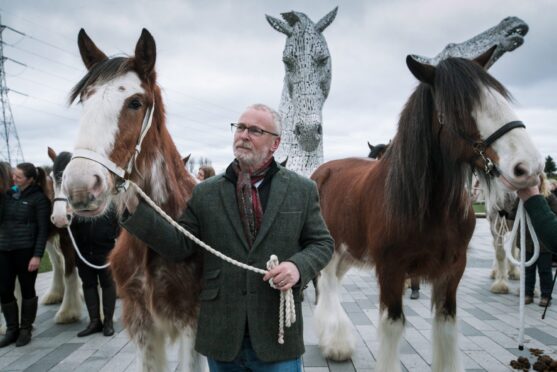
It was some time in 2008, Rab Mitchell reckons, when he first heard about the Kelpies. The former long-distance lorry driver had just retired and he was taking his dog on a walk through scrubland near the Forth & Clyde Canal and the River Carron.
“I met a couple of men standing taking pictures,” Rab, now 78, recalls, “and I said, ‘What ye doing boys?’ Because I speak to everybody. They said, ‘We’re going to build two gigantic horses made of steel.’ I said, ‘Aye right.’
“That was 16 years ago,” he says, smiling, as we both stand in Helix Park on the edge of Falkirk looking up at, yes, two gigantic horses made of steel. The Kelpies, towering over the M9 motorway, are the largest equine sculptures in the world.
Rab, who lives a mile away, comes here every day. “It’s absolutely fantastic what it’s done for this area. These horses…they’re absolutely brilliant.”
The Kelpies brought to life
Opened in April 2014, the Kelpies are 10 years old this month. Their story is one of huge ambition, creativity, technical and financial challenges, the odd sneering dollop of scepticism, and ultimately transformation.
Because these two giant horse heads have put Falkirk on the map. In these past 10 years more than seven million people have visited them from all over the world, bringing some £85 million into the Falkirk region every year.
Visit the Kelpies any day and you can see what these numbers mean in reality. A never-ending stream of dog walkers, cyclists, runners and visitors passing through. Listen and you’ll hear English, Italian, Indian, Spanish and, on the day I visit, French voices.
Dominique Jaumin, a pensioner from the Massif Central, is one of them. Coming to see the Kelpies has been her goal for the last decade. “I came to Scotland 10 years ago and we were driving on the motorway and I saw the Kelpies. And I was astonished,” she said. “I promised to myself one day I would visit.”
This is that day. Have they lived up to her expectations? “Better. Marvellous,” she says.
And tour guide Jennifer Struthers tells me: “We have people coming from New Zealand, Australia, Europe, Asia, Africa, every single continent.”
Yet, when Scottish Canals and Falkirk Council first came up with the idea in the early 2000s, neither could have predicted what would follow.
“We didn’t truly understand the impact the Kelpies could have, certainly nationally, but more internationally,” admits council leader Cecil Meiklejohn. “The area has reinvented Falkirk as a tourist destination. It has also been very important to our local people.”
The journey
But what did it take to get here? Maybe the best person to ask is Andy Scott, the sculptor who designed these towering beasts and one of the men Rab Mitchell met on his dog walk all those years ago.
Most days Andy can be found working in his studio in Los Angeles. But, at the end of March, he visited Falkirk ahead of the 10th anniversary celebrations.
It’s a homecoming, in a way. Andy’s father came from the town. “I was thinking about him earlier,” he tells me. “I was getting a wee bit emotional that he never made it to see these in the end. I remember showing him the original sketches and the look of disbelief on his face. ‘Falkirk? Are you sure?’”
Andy looks across to where his sculptures sit in the landscape, the Ochils behind them. “And there they are.”
The original idea was to build a new entrance to Scotland, Richard Millar, chief operating officer of Scottish Canals, explains. The public body had a fuzzy idea of horses’ heads and invoking the mythical Scottish waterhorses.
“We really liked the Heavy Horse sculpture Andy had done on the M8 motorway,” Richard says, “and we took him out for dinner and said, ‘Look we’ve got this idea’. And he was good enough not to think we were completely mad. He said, ‘I think I can do something with this’. He took it away and he sketched it up. And those sketches are not far off what you see on the ground today.”
With a design in place, the project won £25m from the lottery in 2007. Scottish Canals and Falkirk Council had to match that figure. And then there was the challenge of turning Scott’s three-metre-high maquettes into 30-metre sculptures.
In all, 34,566 individual steel pieces were cut and transported by truck to the site from Yorkshire. The technical challenge was huge. “You’ve got to imagine this as a big construction site,” Andy says.
“Tons of steel lying all over the place and then the fabrication guys in cranes … It was like watching wizards at work.”
‘It’s miraculous they were built’
It is all the more remarkable given this happened against the backdrop of a financial crash. At times there was anxious talk about whether the sculptures might be scaled down to a third of the size.
Did Andy ever worry they wouldn’t happen at all?
“I did, yeah. Several times it felt like it had drifted beyond reach. People forget these were built just coming out of that big recession. It’s miraculous they were built. It took the dedication and tenacity of a lot of people, especially the funders, to stick with it and keep going.”
In the end, once the steel was on site, the Kelpies were constructed in just 90 days.
At the time, many were questioning whether they were good value for money. Why not build local schools or hospitals? To answer that, just spend some time at the Helix Park and see how these sculptures pull people towards them.
“The Kelpies and the Falkirk Wheel are international icons. They are known the world over. We’ve put ourselves on the map of bucket-list destinations,” says John Paterson, CEO of Scottish Canals. Indeed. It is difficult now to imagine Falkirk without them. They have become symbols of Scotland too, turning up in an Irn-Bru advert, and as part of the backdrop on the BBC’s weekend politics show Sunday With Laura Kuenssberg.
How does that make their creator feel?
“I don’t want to sound big-headed, but a little bit vindicated,” Andy suggests. “I remember writing in a report 20 years ago that these things had the potential to be a major cultural landmark. And to see them become that has been an amazing experience.”
Later this month will be a 10th anniversary celebration, with Callum Beattie and the Red Hot Chilli Pipers playing. But this is only the beginning of the story of the Kelpies.
Decades from now, they will still be here. They are what Andy Scott will be remembered for long after he is gone. He is happy with that idea.
“Legacy is important. I was aware of the impact these monumental pieces could have. And to see it actually happening now has been a wonderful thing.
“The idea there were little kids in the area who were toddlers who are now grown adults and for them this has always been here… It’s an amazing thing to get your head around.”
Kelpies 10, a special celebration consisting of free events all day and an evening concert will take place at Helix Park on April 27. More details here.

Enjoy the convenience of having The Sunday Post delivered as a digital ePaper straight to your smartphone, tablet or computer.
Subscribe for only £5.49 a month and enjoy all the benefits of the printed paper as a digital replica.
Subscribe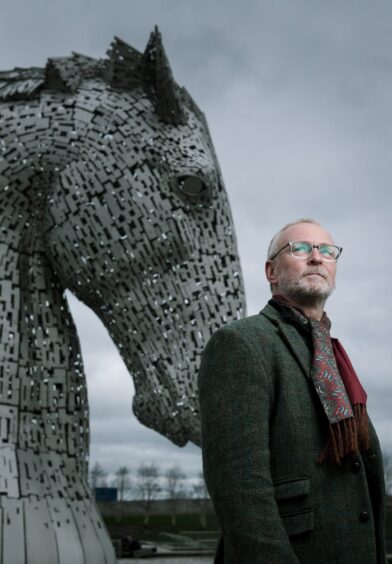 © Andrew Cawley
© Andrew Cawley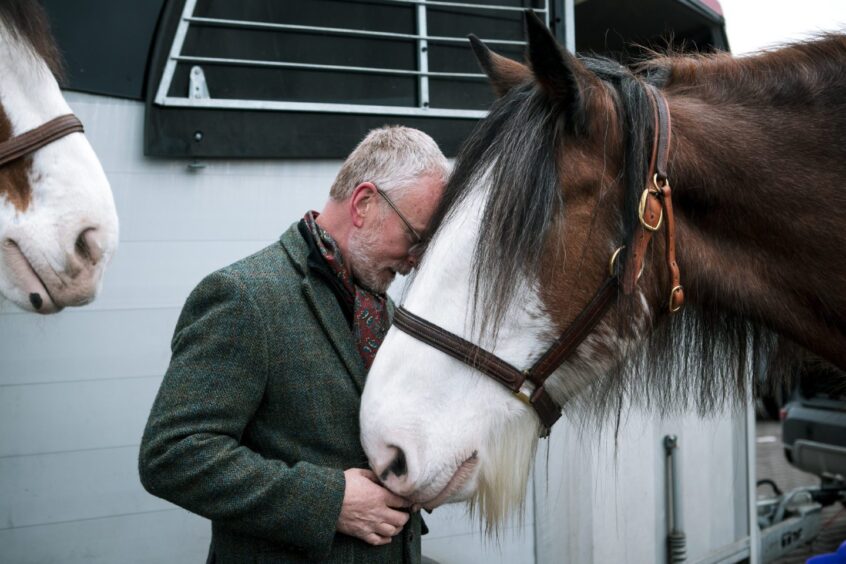 © Andrew Cawley
© Andrew Cawley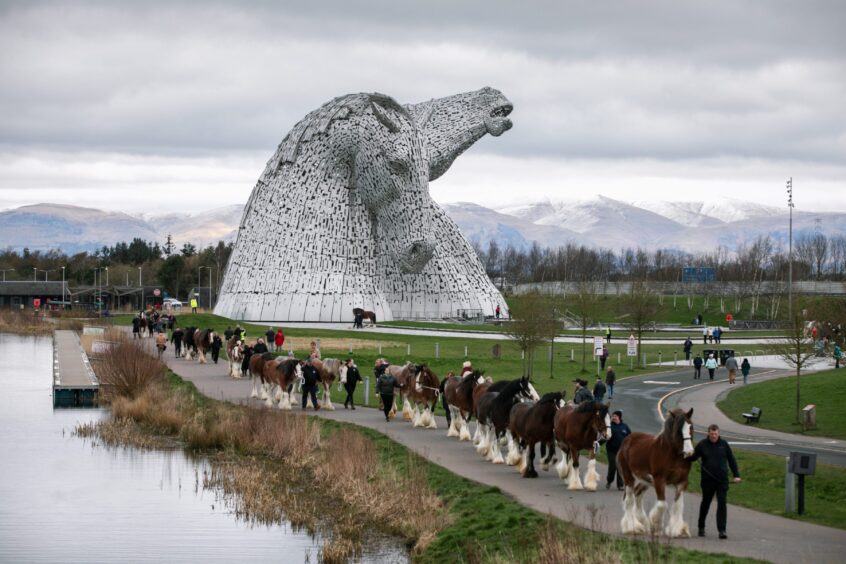 © Andrew Cawley
© Andrew Cawley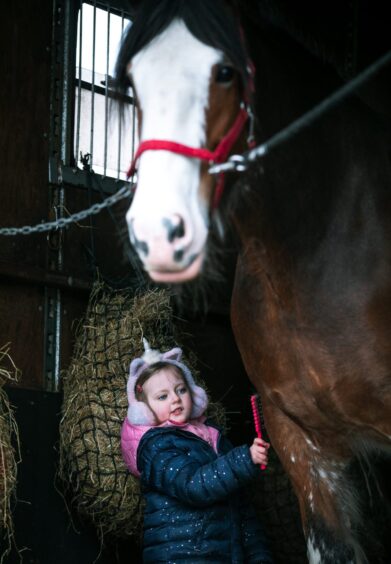 © Andrew Cawley
© Andrew Cawley